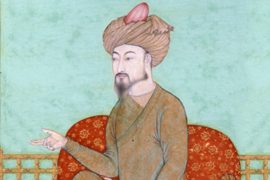Once upon a time, a sanyasi lived in the forest adjoining a village. As is expected of sanyasis, he had renounced the material world – wanting to spend the rest of his life in contemplation, meditation, prayer, and penance. His only material possessions were two pieces of loincloth; one of which he would tie around his waist to cover his modesty, while the other would be washed and left to dry, to use the next day.
One day the sanyasi discovered, to his dismay, that the cloth he had left to dry was riddled with holes; a mouse had taken a liking to it. As luck would have it, the problem persisted, and he had to replace the cloth with a new one every day, leaving him very distressed.
Anxious to get back to his peaceful life, the sanyasi thought of a plan to rid his surroundings of the mouse and started to rear a cat. He then realised that the only way to keep the cat was to feed him some milk. So a cow was procured. To take the cow out for grazing, and to milk her, he employed a servant. But the servant needed his regular meals. So the distraught sanyasi found a young woman from the village and married her.
This story, bequeathed to us through the great Indian oral tradition, seeks to convey the message that the more we try to distance ourselves from the world, and its cares, the more we are drawn into it. The simple loincloth serves as an instrument to establish an entanglement between the sanyasi and the family man, between renunciation and attachment, and between the pursuit of the abstract and the physicality of the material world.
If only the sanyasi could discard the loincloth, perhaps this story could be untold? Not quite. The loincloth is not just a physical possession; it is an apparatus to cover the sanyasi’s idea of modesty which in itself is a construct of the external world. It is as much a cover for the mind, as it is for the body.
In its warp and weft, the material world gets melded with the abstract world of thoughts. Hidden in its folds is the wisdom of ages.
***
Towards the late 20th century, John Bowlby, Mary Ainsworth and Donald Winnicott made pioneering studies of the deeply emotional and psychologically complex interplay between humans, their sense of security, and their material possessions. They theorised that an infant developing a sense of an independent identity that is separate from the mother feels more secure with a transitional object that stands in for her. That object, be it a toy, or a favourite blanket, or a mug, or a photograph, fills many emotional needs. It is a tool to fight loneliness, it is a confidence-booster, and it provides comfort through familiarity. It does not show any compassion; yet unlike a human being who can let the child down, it is utterly reliable, always present, and always under control. In other words, the child can count on it. It is a security blanket. So much so that the child begins to see the object as a natural extension of the self. This is the origin of attachment. And it carries through to adulthood.
In 1890, psychologist and philosopher William James proposed that a man’s ‘self’ included not just his body and consciousness, but everything that he owned and that pertained to him, including his family and friends, his lands and horses, his yacht and bank account. It explains why we are willing to stand up more for our family and friends, than for acquaintances, or strangers; why we defend our assets and not necessarily those of others; and why we think of our nation as superior to other nations. If what is ours gets violated, we ourselves feel violated.
We now have experimental evidence for these theories, more than a hundred years after they were proposed. Psychologists Kyungmi Kim and Marcia Johnson found that during magnetic resonance imaging, objects that a person had imagined as “mine” activated the same brain regions as references to the person’s self.
***
As Aristotle said, “Man is by nature a social animal; an individual who is unsocial naturally and not accidentally is either beneath our notice, or more than human.” It follows that our needs for security are more complex than what one might expect purely on the basis of physical survival. In 1943, psychologist Abraham Maslow proposed a pyramidal heirarchy of needs. The base of the pyramid represents physiological needs (air, water, food). The next layer represents physical safety (shelter, weapons), followed by love and belongings (relationships and community), and esteem (ego, pride) – and finally, at the peak, self-actualization (an optimal emotional state of health in which we realise our full potential). With the possible exception of self-actualisation, our material belongings play an important role in building up the pyramid.
Depending on how an individual relates or clings to the objects that constitute the various layers of the pyramid, four major attachment categories can be identified.
A person is said to have a secure attachment style if, as a child, (s)he felt that the caregiver was reliably present and dependably met the needs. Such a person has a positive feeling about himself/herself and about his/her relationships.
A person is said to have an avoidant attachment style if, as a child, the caregiver pushed him (her) away in times of need. Such a person learns to be independent and is emotionally distant.
A person is said to have an anxious attachment style if, as a child, the caregiver was inconsistent in meeting the needs. Such a person is often anxious, has low self-worth, and exhibits high levels of impulsiveness in relationships.
A person is said to have a fearful attachment style if, as a child, (s)he was in any way harmed by the caregiver. Such a person is suspicious of his/her attachments and often suppresses and denies his/her feelings.
An American study in 1987 revealed that about fifty-six per cent of the people had a secure attachment, while the rest fell into one of the other three categories. This number decreased to forty-nine per cent in 1988 and forty-two per cent in 2011. It is speculated that the fall in secure attachment style, and a corresponding increase in the insecure attachment styles, is closely related to individualism, narcissism, and materialism.
In India, the collapse of the joint family system, rapid urbanisation, easy access to phones and internet, and an upwardly mobile middle class have all contributed to a dilution in the quality of human relationships. A by-product of the increase in the insecure attachment categories is an increase in the number of people seeking emotional solace from material objects. Substituting `relationships with objects’ for `relationships with people’ is a way of bridging the gap between the closeness one has with others, and the closeness one wants with others. In other words, the ‘self’ itself is a social construct, and one doesn’t develop a stable sense of the ‘self’ in the absence of meaningful social relationships; consistent with Aristotle’s assertion that man is a social animal.
It is now evident that some people in the insecure attachment categories anthropomorphise things, that is, treat them as people. For example, it is not uncommon for people to pat, caress, kiss, and give loving names to their cars, bikes, phones, jewellery and other such possessions. Humanising inanimate things is a way of dealing with the unsure or absent human relationships. In India, during the festival of Dusshera, people even deify and worship their tools on the auspicious occasion of Ayudha Puja.
The same people are also vulnerable to hoarding. Attaching sentimental value to things is common, but when such an attachment becomes an obsession, people identify themselves with the memories associated with the things, find it difficult to part with them and experience physical pain at their loss.
In view of the foregoing, it is perhaps time to correct Aristotle: Man is not a social animal, he is a materialistic animal.
The sanyasi learnt this lesson the hard way.
Reference: Further information along with references to the original literature can be found in the article, “Low emotional security can intensify our relationships to our belongings” by Francine Russo, 66-77, Scientific American, May 2018.
-30-
Copyright©Madras Courier, All Rights Reserved. You may share using our article tools. Please don't cut articles from madrascourier.com and redistribute by email, post to the web, mobile phone or social media.Please send in your feed back and comments to editor@madrascourier.com











